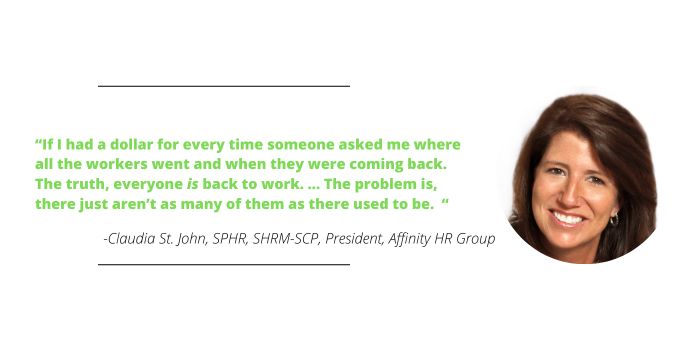Where Did All The Workers Go?

Recently I was sharing a cab with a client on my way to speak at a conference. He turned to me and said that he was interested to hear what I had to say about the state of the U.S. labor market. When I asked him what specifically he was hoping to hear in my talk, he said, “Well, I’m hoping you’re going to tell us where the workers went and when they’re going to come back. When are they going to get off the sofa and back to work. We’re dying out here and people just don’t seem to want to work anymore.”
If only I had a dollar for every time someone asked me this exact same question: where all the workers went and when they were going to come back. The truth, everyone is back to work. They’ve been back to work for a long time. The problem is, there just aren’t as many of them as there used to be. And when I explain this to people like my client, they seem surprised. And that, in turn, surprises me because these labor trends have been on the horizon for a long time. I think business owners have been ignoring the reality that there aren’t enough workers for all the jobs that are out there. In fact, as of August 1, 2023, there were almost 4 million more jobs than there were workers available to fill them. And what’s worse is that we don’t anticipate this changing anytime soon.
In fact, this has become my personal and professional mission it seems – to travel the country speaking to business leaders, making them aware of what they should already know: there simply aren’t enough workers to satisfy all of the promises companies have made to their customers, let alone to support their growth projections. And here’s why:
Eight Million Missing Workers – Since the COVID-19 pandemic, we have lost approximately eight million workers from the workplace. There are a number of places those workers went:
- According to Fed Chairman Jerome Powell, close to 500,000 workers died from COVID
- The Brookings Institute reports that 1.6 million full-time workers have left the workforce due to long COVID
- Goldman Sachs reports that 2.5 million older workers retired earlier than anticipated and are not returning to the workforce
- According to the Society for Human Resources Management (SHRM), there are nearly 2 million fewer women in the labor force due to childcare and familial needs, and
- JP Morgan Chase reports that there are 1 million fewer legal immigrant and non-native born workers than before COVID
These eight million workers represent approximately 5% of the overall workforce, a sizeable and noticeable number to be sure.
An Aging Workforce – Let’s face it, just like you and me, the United States is getting older. According to recent U.S. Census Bureau data, the nation’s median age is pushing 40 years old, and we’re aging faster than at any other time in our history. On average, 10,000 baby boomers turn 65 each and every day and by 2031, the number of people age 65 and over will number an estimated 75 million, almost double what it was just 15 years ago. As these workers age and retire, the number of Generation Z and following Alpha workers are not sizeable enough to replace exiting baby boomers.
Lower Birth Rate – The current U.S. birth rate is among the lowest it has ever been historically and projected to decrease over the rest of the century. We’re simply not giving birth to enough future workers to replace the workers that currently are and will retire. Unlike their older counterparts, Millennials are putting off marriage and childbirth until later in life and are having fewer children than at any time in our history.
Decreased Immigration & Refugee Resettlement – So if we’re not giving birth to enough future workers, the strategy used historically and by other industrialized nations facing a similar aging workforce and low birthrate is to increase immigration. However, the U.S. has done the opposite. Between the years of 2013 and 2018, the annual net immigration stood at just under 1 million workers per year. Since COVID, immigration has largely dried up, with only 241,000 workers joining the workforce in 2021.
Employment Projections – According to the U.S. Bureau of Labor Statistics, from 2021 to 2031, the U.S. economy is projected to add 8.3 million jobs. But we’re already 8 million workers short. And this shortage is anticipated to persist for the foreseeable future. And because of this, the unemployment rate is stuck below 4.2%, what economists say is full employment.
See what I mean? It’s kind of scary. It’s definitely something business leaders should be staying up at night thinking about. Or at least having some conversations with their best and brightest internal and external advisors discussing. Yet, I don’t see this happening. I get the sense that business owners are mistakenly believing that there is a pool of workers waiting on the sidelines for something magical to happen to convince them to rejoin the workforce. But they don’t exist. Everyone is working. This is just the new normal.

If this comes as a surprise to you, you’re not alone. And it’s not too late. What’s required is simply a mindset shift. And most business leaders that we work with have all of the tools to get ahead of the game: they are investing in retention and employee engagement initiatives, they are looking for technology and outsourced/offshore labor alternatives, they are upskilling their existing workers and they are investing in soft-skill training for their managers and supervisors who are the front-line defense for employee turnover and attrition.
The good news is that most of these initiatives cost little to no money to implement and to do well. And all of our clients are well-prepared for the task at hand, and of course we’re here to help them along the way. All it takes is a mindset shift. All it takes is dedication and commitment to do one and only one thing: to value employees for the valuable asset that they are.
September 2023 Q&A with Affinity HR Group
Question: Can I restrict employees from using their smartphones while working? Or when in the workplace?
Answer: Yes, you can restrict most cell phone or smartphone access and/or usage even though the reason behind doing so may vary from situation to situation. This restriction can only be during work times so employees will usually need to be able to access and use their phones during breaks.
Employees' phones and their usage can cause several issues. They can keep employees from properly and efficiently completing their job duties. Or they can distract others in the same space through the conversation or alert tones. If used for streaming music or videos, these phones can cause disruption to the environment as well as slow down internet speed. These phones can bring safety concerns either by being a distraction or by their physical presence in some work areas.
If employees do not need their phones for work purposes, you can establish clear policy that they must be kept out of sight, perhaps locked in a drawer, locker, or vehicle except when used during an approved break period. If there is an emergency situation (i.e., the employee is waiting for a call from a doctor), then allow them to have it on a limited basis with approval.
If employees use their phones for work, you can limit the usage to business purposes and prohibit distractions during work time. This can also apply to remote employees.
Whatever restrictions you want to impose, be sure to have a clear written policy and apply it consistently to all employees.

